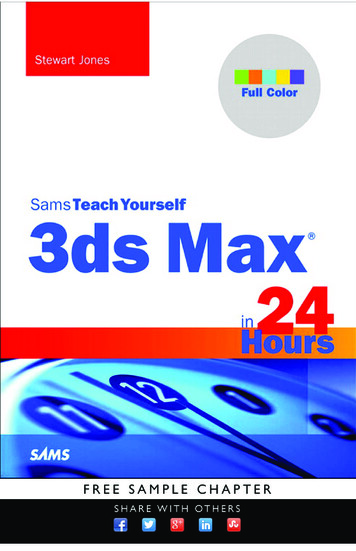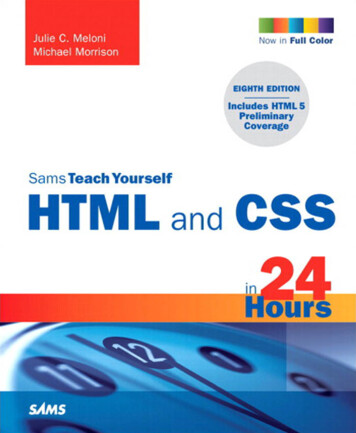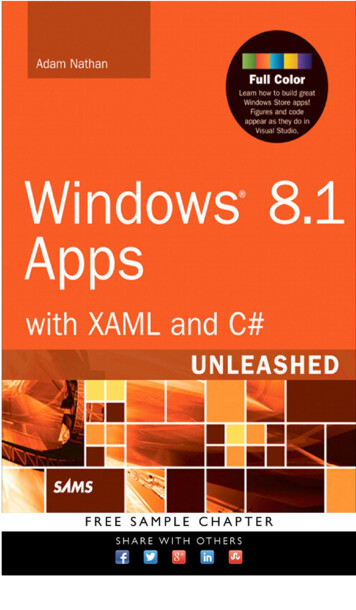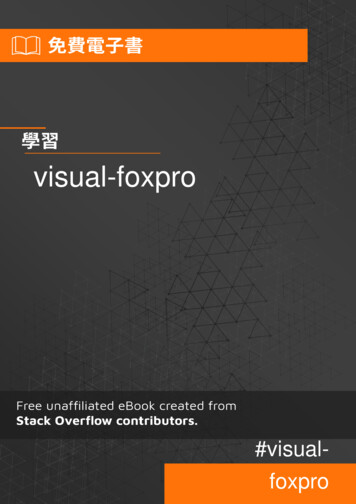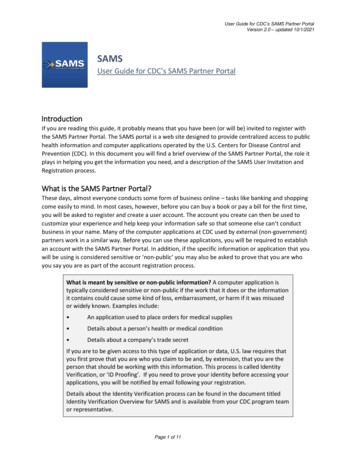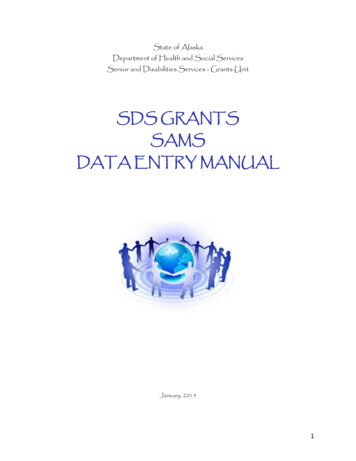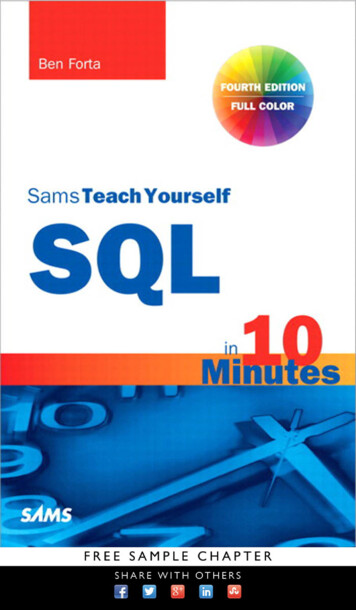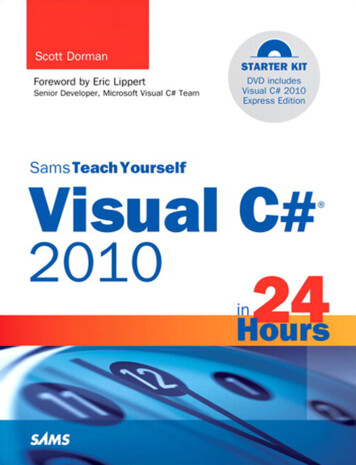
Transcription
Sams Teach Yourself Visual C# 2010 in 24 Hours: Complete Starter KitCopyright 2010 by Pearson EducationAll rights reserved. No part of this book shall be reproduced, stored in a retrieval system, ortransmitted by any means, electronic, mechanical, photocopying, recording, or otherwise, withoutwritten permission from the publisher. No patent liability is assumed with respect to the use ofthe information contained herein. Although every precaution has been taken in the preparation ofthis book, the publisher and author assume no responsibility for errors or omissions. Nor is anyliability assumed for damages resulting from the use of the information contained herein.This material may be distributed only subject to the terms and conditions set forth in theOpen Publication License, v1.0 or later (the latest version is presently available athttp://www.opencontent.org/openpub/).ISBN-13: 978-0-672-33101-5ISBN-10: 0-672-33101-2Library of Congress Cataloging-in-Publication DataDorman, Scott, 1973Sams teach yourself Visual C# 2010 : in 24 hours / Scott Dorman.p. cm.Includes index.ISBN 978-0-672-33101-51. C# (Computer program language) 2. Microsoft Visual C#. I. Millspaugh, A. C. (Anita C.)II. Title.QA76.73.C154D57 2010005.13’3—dc222010018992Printed in the United States on AmericaFirst Printing June 2010TrademarksAll terms mentioned in this book that are known to be trademarks or service marks have beenappropriately capitalized. Sams Publishing cannot attest to the accuracy of this information. Useof a term in this book should not be regarded as affecting the validity of any trademark or servicemark.Warning and DisclaimerEvery effort has been made to make this book as complete and as accurate as possible, but nowarranty or fitness is implied. The information provided is on an “as is” basis. The author and thepublisher shall have neither liability nor responsibility to any person or entity with respect to anyloss or damages arising from the information contained in this book.Bulk SalesSams Publishing offers excellent discounts on this book when ordered in quantity for bulk purchases or special sales. For more information, please contactU.S. Corporate and Government or sales outside of the U.S., please contactInternational Salesinternational@pearsoned.comSams Publishing800 East 96th StreetIndianapolis, Indiana, 46240 USAEditor-in-ChiefKaren GettmanExecutive EditorNeil RoweAcquisitions EditorBrook FarlingDevelopmentEditorMark RenfrowManaging EditorKristy HartSenior ProjectEditorLori LyonsCopy EditorApostrophe EditingServicesIndexerPublishing Works,Inc.ProofreaderWater CrestPublishing, Inc.Technical EditorsClaudio LasallaEric LippertPublishingCoordinatorCindy TeetersBook DesignerGary AdairCompositionJake McFarlandNonie Ratcliff
1IntroductionIn late December 1998, Microsoft began working on a new development platformthat would result in an entirely new way to create and run next-generation applications and web services. This new platform was called the .NET Framework and waspublicly announced in June 2000.The .NET Framework unified the existing Windows interfaces and services under asingle application programming interface (API) and added many of the emergingindustry standards, such as Simple Object Access Protocol (SOAP), and many existingMicrosoft technologies, such as the Microsoft Component Object Model (COM andCOM ) and Active Server Pages (ASP). In addition to providing a consistent development experience, the .NET Framework enabled developers to focus on the applicationlogic rather than more common programming tasks with the inclusion of one of thelargest available class libraries.Finally, by running applications in a managed runtime environment that automatically handled memory allocation and provided a “sandboxed” (or restricted access)environment, many common programming errors and tasks were reduced and, insome cases, eliminated.Now, nearly 10 years later, the .NET Framework continues to evolve by supportingnew technologies and industry standards, adding support for dynamic languagesand providing even more classes that are built-in. At Microsoft’s Professional Developer Conference (PDC) in 2008, one of the themes was “make the simple things easyand the difficult things possible.” The .NET Framework achieved that with its firstrelease, and each release after that continues to realize that goal.The C# (pronounced “See Sharp”) programming language was developed with the.NET Framework by Anders Hejlsberg, Scott Wiltamuth, and Peter Golde and was firstavailable in July 2000. Having been written specifically for the .NET Framework, it isconsidered by many to be the canonical language of the .NET Framework. As a language, C# drew inspiration for its syntax and primary features from Delphi 5, C ,and Java 2. C# is a general-purpose, object-oriented, type-safe programming language used for writing applications of any type. Just as the .NET Framework hascontinued to evolve, C# has evolved to keep pace with the changes in the .NETFramework and to introduce new language features that continue to make thesimple things easy and the difficult things possible.
2IntroductionAlthough there are more than 50 different programming languages supported by the.NET Framework, C# continues to be one of the most popular and modern generalpurpose languages.Audience and OrganizationThis book is targeted toward the non-.NET programmer who is venturing into .NETfor the first time or an existing .NET programmer trying to learn C#. If you are firstlearning how to program, this book can help you on your way, but it isn’t intendedto be a beginning programming book. The book is designed with the purpose of getting you familiar with how things are done in C# and becoming productive asquickly as possible. I take a different approach in this book by using a more holisticview of the language. I chose this approach to give you the most complete understanding of the C# language by focusing on how the current language featuresenable you to solve problems.This book is divided in to five parts, each one focusing on a different aspect of thelanguage. These parts progress from the simple fundamentals to more advancedtopics, so I recommend reading them in order:. Part I, “C# Fundamentals,” teaches you about the .NET Framework, the objectoriented programming features of C#, the fundamentals of C# type system,and events. Part II, “Programming in C#,” teaches you the fundamentals of programming.You learn how to perform loops and work with strings, regular expressions, andcollections. Then we move to more advanced topics, such as exception management and generics. Finally, we finish with anonymous functions (lambdas),query expressions (LINQ), and how to interact with dynamic languages. Part III, “Working with Data,” shows how to interact with the file system andstreams, create and query XML documents, and work with databases. Part IV, “Building an Application Using Visual Studio,” starts with an introduction to Visual Studio 2010 and debugging applications. We then build a Windows client application using data binding and validation. Next, you learnhow to build an application for the web. Part V, “Diving Deeper,” introduces the advanced concepts of attribute programming, dynamic types, and language interoperability. You learn the fundamentals of how the .NET Framework organizes memory, how the garbagecollector works, and how the .NET Framework provides mechanisms for deterministic finalization. Next, you learn how to use multiple threads and parallelprocessing. Finally, you look at some of the newer technologies from Microsoft
Closing Thoughts3built on the .NET Framework, such as Silverlight, PowerShell, and the EntityFramework.By the Way boxes provide useful sidebar information that you can read immediately or circle back to without losing the flow of the topic at hand.By theWayDid You Know? boxes highlight information that can make your programming moreeffective.Did youKnow?Watch Out! boxes focus your attention on problems or side effects that can occurunder certain situations.WatchOut!Throughout the book, I use examples that show real-world problems and how tosolve them using C# and the .NET Framework. In Part IV, we actually build somecomplete applications from scratch that draw on the skills you learned in the previous three parts.Conventions Used in This BookThis book uses several design elements and conventions to help you prioritize andreference the information it contains.New terms appear in bold for emphasis.In addition, this book uses various typefaces to help you distinguish code from regular English. Code is presented in a monospace font. Placeholders—words or charactersthat represent the real words or characters you would type in code—appear in italicmonospace. When you are asked to type or enter text, that text appears in bold.Some code statements presented in this book are too long to appear on a single line.In these cases, a line continuation character is used to indicate that the followingline is a continuation of the current statement.Closing ThoughtsThe Microsoft .NET Framework and C# continue to be one of the most powerful yetelegant languages I’ve worked with and provide many exciting opportunities fordeveloping the next “killer application.” You won’t be an expert in C# when youfinish this book, but I hope you feel comfortable about creating applications in .NETand C#.
63HOUR 3Understanding Classes andObjects the C# WayWhat You’ll Learn in This Hour:.Object- and Component-Oriented ProgrammingClasses in C#Scope and AccessibilityMethods and PropertiesNested and Partial ClassesStatic Classes and DataObject InitializersA class is the fundamental programming concept in C#, defining both representationand behavior in a single unit. Classes provide the language support required forobject-oriented and component-oriented programming and are the primary mechanism you use to create user-defined types. Traditionally, object-oriented programming languages have used the term “type” to refer to behavior, whereas valueoriented programming languages have used it to refer to data representation. In C#,it is used to mean both data representation and behavior. This is the basis of thecommon type system and means two types are assignment-compatible if, and onlyif, they have compatible representations and behaviors.In this hour, you learn the basics of both object-oriented and component-orientedprogramming. When you understand these concepts, you move on to creating a classin C# and examining how it fulfills the goals of object-oriented and componentoriented programming. You learn about the different accessibility models, how to create and use properties and methods, and about optional and named parameters.
64HOUR 3: Understanding Classes and Objects the C# WayObject-Oriented ProgrammingBefore we start talking about classes in detail, you need to understand the benefits ofobject-oriented programming and understand how it relates to C#. Object-orientedprogramming helps you think about the problem you want to solve and gives you away to represent, or model, that problem in your code. If you do a good job modeling the problem, you end up with code that’s easy to maintain, easy to understand,and easy to extend.By theWayMaintainable CodeThere is, of course, more to creating code that’s easy to maintain, understand,and extend than just getting the model correct. The implementation also has tobe correct, readable, and correctly organized.As previously mentioned, classes are the fundamental programming concept in C#,defining both representation and behavior in a single unit. Put another way, a classis a data structure that combines data storage with methods for manipulating thatdata. Classes are simply another data type that becomes available to you in muchthe same way any of the predefined types are available to you. Classes provide theprimary mechanism you use to create user-defined types.The four primary concepts of object-oriented programming are encapsulation, abstraction, inheritance, and polymorphism. In this hour, you learn about encapsulation andabstraction. In the next hour, you learn about inheritance and polymorphism.Encapsulation and AbstractionEncapsulation enables a class to hide the internal implementation details and toprotect itself from unwanted changes that would result in an invalid or inconsistentinternal state. For that reason, encapsulation is also sometimes referred to as datahiding.As an example of encapsulation at work, think about your car. You start your car inthe morning by inserting a key and turning it (or simply pushing a button, in somecases). The details of what happens when you turn the key (or push the button) thatactually causes the engine to start running are hidden from you. You don’t need toknow about them to start the car. It also means you can’t influence or change theinternal state of the engine except by turning the ignition key.By hiding the internal details and data, you create a public interface or abstractionrepresenting the external details of a class. This abstraction describes what actions the
Component-Oriented Programmingclass can perform and what information the class makes publicly available. As longas the public interface does not change, the internal details can change in any wayrequired without having an adverse affect on other classes or code that depends on it.By keeping the public interface of a class small and by providing a high degree offidelity between your class and the real-world object it represents, you help ensurethat your class will be familiar to other programmers who need to use it.Let’s look at our car example again. By encapsulating the details of what happenswhen you start your car and providing an action, StartCar, and information, suchas IsCarStarted, we have defined a public interface, thereby creating an abstraction(or at least a partial abstraction, because cars do much more than just start) of a car.Component-Oriented ProgrammingComponent-oriented programming is a technique of developing software applications by combining pre-existing and new components, much the same way automobiles are built from other components. Software components are self-contained, selfdescribing packages of functionality containing definitions of types that expose bothbehavior and data.C# supports component-oriented programming through the concepts of properties,methods, events, and attributes (or metadata), allowing self-contained and selfdescribing components of functionality called assemblies.Classes in C#Now that you have a basic understanding of object-oriented and component-orientedprogramming, it is time to see how C# enables these concepts to become reality byusing classes. You have actually already used classes in the examples and exercisesfrom the previous two hours.Classes in C# are reference types that implicitly derive from object. To define a class,you use the class keyword. Look at the application you built at the end of Hour 1,“The .NET Framework and C#.” Everything you did was inside a class namedProgram.The body of the class, defined by the opening and closing braces, is where you definethe data and behavior for the class.65
66HOUR 3: Understanding Classes and Objects the C# WayScope and Declaration SpaceWe briefly mentioned scope and declaration space in Hour 1, saying that scopedefines where you can use a name, whereas declaration space focuses on where thatname is unique. Scope and declaration space are closely related, but there are a fewsubtle differences.A more formal definition is that scope is an enclosing context or region that defineswhere a name can be used without qualification.In C#, both scope and declaration space is defined by a statement block enclosed bybraces. That means namespaces, classes, methods, and properties all define both ascope and a declaration space. As a result, scopes can be nested and overlap each other.If scope defines the visibility of a name and scopes are allowed to overlap, any namedefined in an outer scope is visible to an inner scope, but not the other way around.In the code shown in Listing 3.1, the field age is in scope throughout the entire bodyof Contact, including within the body of F and G. In F, the use of age refers to thefield named age.LISTING 3.1Scope and Declaration Spaceclass Contact{public int age;public void F(){age 18;}public void G(){int age;age 21;}}However, in G, the scopes overlap because there is also a local variable named agethat is in scope throughout the body of G. Within the scope of G, when you refer toage, you are actually referring to the locally scoped entity named age and not theone in the outer scope. When this happens, the name declared in the outer scope ishidden by the inner scope.Figure 3.1 shows the same code with the scope boundaries indicated by the dottedand dashed rectangles.
Scope and Declaration Spaceclass Contact{int age;void F(){age 18;}67FIGURE 3.1Nested scopesand hidingvoid G(){int age;age 21;}}Declaration space, on the other hand, is an enclosing context or region in which notwo entities are allowed to have the same name. In the Contact class, for example,you are not allowed to have anything else named age in the body of the class,excluding the bodies of F and G. Likewise, inside the body of G, when you redeclareage, you aren’t allowed to have anything else named age inside the declarationspace of G.You learn about method overloading a bit later this hour, but methods are treated alittle differently when it comes to declaration spaces. If you consider the set of alloverloaded methods with the same name as a single entity, the rule of having aunique name inside a declaration space is still satisfied.Try It YourselfWorking with ScopeTo explore the differences between scope and declaration space, follow thesesteps. Keep Visual Studio open at the end of this exercise because you will usethis application later.1. Create a new Console application.2. Add a new class file named Contact.cs that looks like Listing 3.1.3. In G, add a Console.WriteLine statement at the end of the method that printsthe value of age.
68HOUR 3: Understanding Classes and Objects the C# Way4. In the Main method of the Program.cs file, enter the following code to create anew instance of the Contact class and print the current value of age:Contact c new riteLine(c.age);G();Console.WriteLine(c.age);5. Run the application using Ctrl F5 and observe that the output matches what isshown in Figure 3.2.FIGURE 3.2Working withscope AccessibilityAccessibility enables you to control the visibility, or accessibility, of an entity outsideof its containing scope. C# provides this through access modifiers, which specify constraints on how members can be accessed outside the boundary of the class and, insome cases, even constrain inheritance. A particular class member is accessible whenaccess to that member has been allowed; conversely, the member is inaccessiblewhen access has been disallowed.These access modifiers follow a simple set of contextual rules that determine whencertain types of accessibility are permitted:. Namespaces are not allowed to have any access modifiers and are alwayspublic. Classes default to internal accessibility but are allowed to have either publicor internal declared accessibility. A nested class, which is a class definedinside of another class, defaults to private accessibility but can have any ofthe five kinds of declared accessibility. Class members default to private accessibility but can have any of the fivekinds of declared accessibility.These rules also define the default accessibility, which occurs when a member doesnot include any access modifiers.
Scope and Declaration SpaceExplicitly Declaring AccessibilityAlthough C# provides reasonable default access modifiers, you should alwaysexplicitly declare the accessibility of your class members. This prevents unintended ambiguity, indicates that the choice was a conscious decision, and is selfdocumenting.69By theWayThe access modifiers supported by C# are shown in Table 3.1.TABLE 3.1Access ModifiersModifierDescriptionpublicAccess is not limited.protectedAccess is limited to the containing class or types derivedfrom the containing class.internalAccess is limited to the containing assembly.protected internalAccess is limited to the containing assembly or typesderived from the containing class.privateAccess is limited to the containing class only.Protected InternalBe careful when using protected internal accessibility because it is effectivelyprotected or internal. C# does not provide a concept of protected andinternal.Fields and ConstantsFields are variables that represent data associated with a class. In other words, a fieldis simply a variable defined in the outermost scope of a class. If you recall from Hour1, a field can be either an instance field or a static field, and for both types of field,you can specify any of the five access modifiers. Typically, fields are private, which isthe default.If a field, no matter whether it is an instance or static field, is not given an initialvalue when it is declared, it is assigned the default value appropriate for its type.Similar to fields, constants can be declared with the same access modifiers. Because aconstant must have a value that can be computed at compile time, it must beassigned a value as part of its declaration. One benefit of requiring a value that canbe computed at compile time is that a constant can depend on other constants.WatchOut!
70HOUR 3: Understanding Classes and Objects the C# WayA constant is usually a value type or a string literal because the only way to create anon-null value of a reference type other than string is to use the new operator,which is not permitted.WatchOut!Constants Should Be ConstantWhen creating constants, you should be sure that the value is something that islogically constant forever. Good constants are things that never change, such asthe value of Pi, the year Elvis was born, or the number of items in a mol.If you need to create a field that has constant-like behavior but uses a type notallowed in a constant declaration, you can use a static read-only field instead byspecifying both the static and readonly modifiers. A read-only field can be initialized only as part of its declaration or in a constructor. Try It YourselfWorking with FieldsBy following these steps, you explore how to create a class containing data andhow to provide access to that data. If you closed Visual Studio, repeat the previousexercise first. Keep Visual Studio open at the end of this exercise because you willuse this application later.1. Create a new Console application.2. Add a new class file named Contact.cs. Inside the body of the class, declarethree private fields named firstName, lastName, and dateOfBirth of typestring, string, and DateTime, respectively.3. Add the following method to the class. You learn more about methods later inthis hour and more about the StringBuilder class in Hour 8, “Using Stringsand Regular Expressions”:public override string ToString(){StringBuilder stringBuilder new : {0} {1}\r\n”, this.firstName, this.lastName);stringBuilder.AppendFormat(“Date of Birth: {0}\r\n”, this.dateOfBirth);return stringBuilder.ToString();}4. In the Main method of the Program.cs file, enter the following:Contact c new Contact();Console.WriteLine(c.ToString());
Scope and Declaration Space715. Run the application using Ctrl F5 and observe that the output matches what isshown in Figure 3.3.FIGURE 3.3Working withfields PropertiesIf fields represent state and data but are typically private, there must be a mechanismthat enables the class to provide that information publicly. Knowing the differentaccessibility options allowed it would be tempting to simply declare the class fields tohave public accessibility.This would allow us to satisfy the rules of abstraction, but this would then violate therules of encapsulation because the fields could be directly manipulated. How, then, isit possible to satisfy both the rules of encapsulation and abstraction? What is neededis something accessed using the same syntax as a field but that can define differentaccessibility than the field itself. Properties enable us to do exactly that. A propertyprovides a simple way to access a field, called the backing field, which can be publicly available while still allowing the internal details of that field to be hidden. Justas fields can be static, properties can also be static and are not associated with aninstance of the class.Although fields declare variables, which require storage in memory, properties do not.Instead, properties are declared with accessors that enable you to control whether avalue can be read or written and what should occur when doing so. The get accessorenables the property value to be read, whereas the set accessor enables the value tobe written.Listing 3.2 shows the simplest way to declare a property. When using this syntax,known as automatic properties, you omit the backing field declaration and mustalways include both the get and set accessor without a declared implementation,which the compiler provides.LISTING 3.2Declaring an Automatic Propertyclass Contact{public string FirstName{get;set;}}
72HOUR 3: Understanding Classes and Objects the C# WayIn fact, the compiler transforms the code shown in Listing 3.2 into code that looksroughly like that shown in Listing 3.3.LISTING 3.3Declaring a Propertyclass Contact{private string firstName;public string FirstName{get{return this.firstName;}set{this.firstName value;}}}WatchOut!Automatic PropertiesAutomatic properties are convenient, especially when you implement a large number of properties. This convenience does come at a slight cost, however.Because you don’t provide a body for the accessors, you can’t specify any logicthat executes as part of that accessor, and both accessors must be declaredusing the automatic property syntax. As a result, if at some point later you realizethat you need to provide logic for either of the accessors, you need to add a backing field and the appropriate logic to both accessors.Fortunately, this change doesn’t affect the public interface of your class, so it issafe to make, although it might be a bit tedious.The get accessor uses a return statement, which simply instructs the accessor toreturn the value indicated. In the set accessor of the code in Listing 3.3, the classfield firstName is set equal to value, but where does value come from? From Table1.6 in Chapter 1, you know that value is a contextual keyword. When used in aproperty set accessor, the value keyword always means “the value that was providedby the caller” and is always typed to be the same as the property type.By default, the property accessors inherit the accessibility declared on the propertydefinition itself. You can, however, declare a more restrictive accessibility for eitherthe get or the set accessor.
Scope and Declaration Space73You can also create calculated properties that are read-only and do not have a backing field. These calculated properties are excellent ways to provide data derived fromother information.Listing 3.4 shows a calculated FullName property that combines the firstName andlastName fields.LISTING 3.4Declaring a Calculated Propertyclass Contact{private string firstName;private string lastName;public string FullName{get{return this.firstName “ “ this.lastName;}}}Read-Only and Write-Only PropertiesFor explicitly declared properties, you are allowed to omit either accessor. Byincluding only the get accessor, you create a read-only property. To create theequivalent of a read-only property using automatic properties, you would declarethe set accessor to be private.By theWayBy including only the set accessor, or declaring the get accessor to be private,you create a write-only property. In practice, you should avoid write-only properties.Because properties are accessed as if they were fields, the operations performed in theaccessors should be as simple as possible. If you need to perform more complex operations or perform an operation that could be time-consuming or expensive (resourceconsuming), it might be better to use a method rather than a property.Try It YourselfWorking with PropertiesTo modify the Contact class to allow access to the private data using properties,and to use automatic and calculated properties, follow these steps. If you closedVisual Studio, repeat the previous exercise first. Be sure to keep Visual Studioopen at the end of this exercise because you will use this application later.
74HOUR 3: Understanding Classes and Objects the C# Way1. Open the Contact.cs file.2. Add a new public property named DateOfBirth that enables reading and writing to the dateOfBirth field.3. Remove the firstName and lastName fields and create a FirstName andLastName property as automatic properties.4. Add a calculated property named FullName, which combines the values of theFirstName and LastName properties. This should be similar to the calculatedproperty shown in Listing 3.4.5. Modify the ToString method to make use of the new FullName propertyinstead of performing the string concatenation directly.6. In the Main method of the Program.cs file, enter the following code after theConsole.WriteLine statement:c.FirstName “Jim”;c.LastName “Morrison”;c.DateOfBirth new DateTime(1943, 12, 8);Console.WriteLine(c.ToString());7. Run the application using Ctrl F5, and observe that the output matches what isshown in Figure 3.4.FIGURE 3.4Working withproperties MethodsIf fields and properties define and implement data, methods, which are also calledfunctions, define and implement a behavior or action that can be p
Sams teach yourself Visual C# 2010 : in 24 hours / Scott Dorman. p. cm. Includes index. ISBN 978--672-33101-5 1. C# (Computer program language) 2. Microsoft Visual C#. I. Millspaugh, A. C. (Anita C.) II. Title. QA76.73.C154D57 2010 005.13'3—dc22 2010018992 Printed in the United States on America First Printing June 2010 Trademarks
